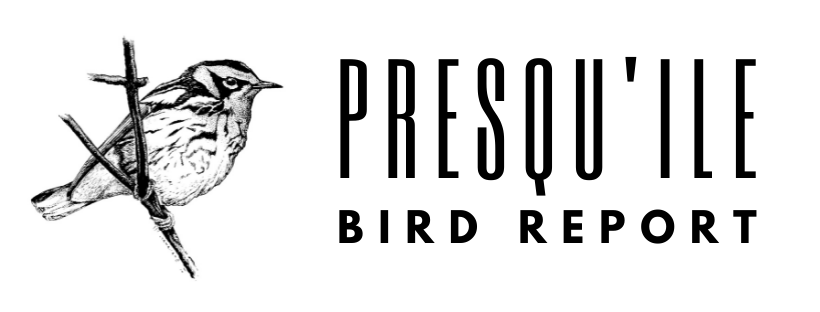
By Doug McRae
Highlights: COMMON GOLDENEYE, CATTLE EGRET, EASTERN MEADOWLARK, PINE SISKIN
The oppressive heat and general lack of birders made for a slow week and a slim report. It should be noted however that swallows and blackbirds are starting to flock and gather at dusk over the marsh and a meadowlark near the lighthouse (where they do not breed) shows that birds are moving.
Two male GREEN-WINGED TEAL off Beach 3 on 4 Jul were unexpected, as was a male COMMON GOLDENEYE on 3 Jul off the foot of Huff Rd., just west of the park gate. A flock of seven MERGANSERS, not identified to species (either Common or Red-breasted), flew past the Lighthouse this evening and are the first in a few weeks.
PIED-BILLED GREBES are becoming more obvious now that their chicks are larger. Eleven were seen from the Camp Office viewing deck on 4 Jul. The long-staying CATTLE EGRET was seen daily along Huff Rd. from 29 Jun until 3 Jul and may still be around, although several searches over the past few days have failed to find it. The Park staff conducted their annual count of herons nesting on High Bluff Island and found 39 GREAT EGRET nests and a record 111 BLACK-CROWNED NIGHT-HERON nests. The latter have been observed feeding frequently on colonial bird chicks, fish regurgitated by cormorants and Garter Snakes, some of which are hung in trees!
A VIRGINIA RAIL was seen crossing the main road just south of the Beach 1 Rd. on 4 Jul. So far only resident nesting shorebirds have been reported but the first fall migrants could show up any day. Single BONAPARTE’S GULLS were seen on 2 and 4 Jul near Salt Pt. RING-BILLED GULLS are starting to fledge from the colony on Gull Is. with over 100 barely flying young noted on 4 Jul. Two fledged HERRING GULLS were seen the same day. Family parties of ROUGH-WINGED SWALLOW were noted on 30 Jun and 4 Jul. Two BANK SWALLOWS were seen over the marsh on 3 Jul and at least 25 BARN SWALLOWS – a mix of adults and young - were flying over the marsh at dusk on 4 Jul.
A NORTHERN WATERTHRUSH has been seen at a Bayshore Rd. birdbath several times since 29 Jun at a site where they do not breed, suggesting a possible migrant. A WHITE-THROATED SPARROW, a local breeding species, was seen in the Fingers on 4 Jul. The first fledged ROSE-BREASTED GROSBEAK was seen near the gate on 30 Jun. An EASTERN MEADOWLARK seen on a lawn near the Lighthouse on 28 Jun is hard to explain, other than it is moving since they don’t breed in the park. A loose group of 175 COMMON GRACKLES were seen flying into the marsh, another sign of fall migration. BROWN-HEADED COWBIRDS have become scarce in recent weeks but one was seen on the Owen Pt. Trail on 4 Jul. A few PURPLE FINCHES have been visiting feeders along Bayshore Rd. through the week but a single PINE SISKIN at a feeder on 4 Jul is hard to explain.
I am going to be away for the next two months counting shorebirds on the James Bay coast so Bill Gilmour has kindly agreed to step in and do the weekly report while I’m gone. Please email your sightings to him at tbki2012@gmail.com.
Presqu’ile Provincial Park is located on the north shore of Lake Ontario, just south of the town of Brighton. It can be reached from either Hwy. 401 or Cty. Rd. 2 and is well signed. A Park map can be found in the information tabloid available at the Park gate. Presqu’ile’s two offshore islands – Gull and High Bluff – support a large multi-species colonial bird nesting area and access is not permitted during the breeding season.


